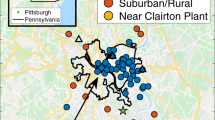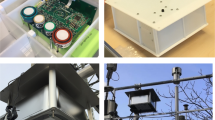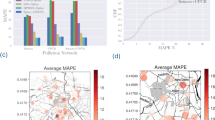Abstract
Background
Statistical models of air pollution enable intra-urban characterization of pollutant concentrations, benefiting exposure assessment for environmental epidemiology. The new generation of low-cost sensors facilitate the deployment of dense monitoring networks and can potentially be used to improve intra-urban models of air pollution.
Objective
Develop and evaluate a spatiotemporal model for nitrogen dioxide (NO2) in the Puget Sound region of WA, USA for the Adult Changes in Thought Air Pollution (ACT-AP) study and assess the contribution of low-cost sensor data to the model’s performance through cross-validation.
Methods
We developed a spatiotemporal NO2 model for the study region incorporating data from 11 agency locations, 364 supplementary monitoring locations, and 117 low-cost sensor (LCS) locations for the 1996–2020 time period. Model features included long-term time trends and dimension-reduced land use regression. We evaluated the contribution of LCS network data by comparing models fit with and without sensor data using cross-validated (CV) summary performance statistics.
Results
The best performing model had one time trend and geographic covariates summarized into three partial least squares components. The model, fit with LCS data, performed as well as other recent studies (agency cross-validation: CV- root mean square error (RMSE) = 2.5 ppb NO2; CV- coefficient of determination (\({R}^{2}\)) = 0.85). Predictions of NO2 concentrations developed with LCS were higher at residential locations compared to a model without LCS, especially in recent years. While LCS did not provide a strong performance gain at agency sites (CV-RMSE = 2.8 ppb NO2; CV-\({R}^{2}\) = 0.82 without LCS), at residential locations, the improvement was substantial, with RMSE = 3.8 ppb NO2 and \({R}^{2}\) = 0.08 (without LCS), compared to CV-RMSE = 2.8 ppb NO2 and CV-\({R}^{2}\) = 0.51 (with LCS).
Impact
We developed a spatiotemporal model for nitrogen dioxide (NO2) pollution in Washington’s Puget Sound region for epidemiologic exposure assessment for the Adult Changes in Thought Air Pollution study. We examined the impact of including low-cost sensor data in the NO2 model and found the additional spatial information the sensors provided predicted NO2 concentrations that were higher than without low-cost sensors, particularly in recent years. We did not observe a clear, substantial improvement in cross-validation performance over a similar model fit without low-cost sensor data; however, the prediction improvement with low-cost sensors at residential locations was substantial. The performance gains from low-cost sensors may have been attenuated due to spatial information provided by other supplementary monitoring data.
This is a preview of subscription content, access via your institution
Access options
Subscribe to this journal
Receive 6 print issues and online access
$259.00 per year
only $43.17 per issue
Buy this article
- Purchase on Springer Link
- Instant access to full article PDF
Prices may be subject to local taxes which are calculated during checkout





Similar content being viewed by others
Data availability
Data used in this study were a mix of publicly available data sources (e.g. agency data), data available upon request (e.g. supplementary monitoring campaigns at non-confidential locations), and unavailable/protected information (e.g. ACT-AP participant geolocations).
References
Dockery DW, Pope CA, Xu X, Spengler JD, Ware JH, Fay ME, et al. An association between air pollution and mortality in six U.S. cities. N Engl J Med. 1993;329:1753–9.
Miller KA, Siscovick DS, Sheppard L, Shepherd K, Sullivan JH, Anderson GL, et al. Long-term exposure to air pollution and incidence of cardiovascular events in women. N Engl J Med. 2007;356:447–58.
Kirwa K, Szpiro AA, Sheppard L, Sampson PD, Wang M, Keller JP, et al. Fine-scale air pollution models for epidemiologic research: insights from approaches developed in the multi-ethnic study of atherosclerosis and air pollution (MESA Air). Curr Envir Health Rep. 2021;8:113–26.
Lindström J, Szpiro AA, Sampson PD, Oron AP, Richards M, Larson TV, et al. A flexible spatio-temporal model for air pollution with spatial and spatio-temporal covariates. Environ Ecol Stat. 2014;21:411–33.
Sampson PD, Szpiro AA, Sheppard L, Lindström J, Kaufman JD. Pragmatic estimation of a spatio-temporal air quality model with irregular monitoring data. Atmos Environ. 2011;45:6593–606.
Szpiro AA, Sampson PD, Sheppard L, Lumley T, Adar SD, Kaufman J. Predicting intra-urban variation in air pollution concentrations with complex spatio-temporal dependencies. Environmetrics. 2010;21:606–31.
Keller J, Olives C, Kim SY, Sheppard L, Sampson P, Szpiro A, et al. A unified spatiotemporal modeling approach for predicting concentrations of multiple air pollutants in the multi-ethnic study of atherosclerosis and air pollution. Environ Health Perspect. 2015;123:301–9.
Jerrett M, Arain MA, Kanaroglou P, Beckerman B, Crouse D, Gilbert NL, et al. Modeling the intraurban variability of ambient traffic pollution in Toronto, Canada. J Toxicol Environ Health A. 2007;70:200–12.
Young MT, Bechle MJ, Sampson PD, Szpiro AA, Marshall JD, Sheppard L, et al. Satellite-based NO2 and model validation in a national prediction model based on universal kriging and land-use regression. Environ Sci Technol. 2016;50:3686–94.
Ryan PH, LeMasters GK. A review of land-use regression models for characterizing intraurban air pollution exposure. Inhal Toxicol. 2007;19:127–33.
Briggs DJ, de Hoogh C, Gulliver J, Wills J, Elliott P, Kingham S, et al. A regression-based method for mapping traffic-related air pollution: application and testing in four contrasting urban environments. Sci Total Environ. 2000;253:151–67.
Briggs DJ, Collins S, Elliott P, Fischer P, Kingham S, Lebret E, et al. Mapping urban air pollution using GIS: a regression-based approach. Int J Geogr Inf Sci. 1997;11:699–718.
Ross Z, English PB, Scalf R, Gunier R, Smorodinsky S, Wall S, et al. Nitrogen dioxide prediction in Southern California using land use regression modeling: potential for environmental health analyses. J Expo Sci Environ Epidemiol. 2006;16:106–14.
Gilbert NL, Goldberg MS, Beckerman B, Brook JR, Jerrett M. Assessing spatial variability of ambient nitrogen dioxide in montréal, canada, with a land-use regression model. J Air Waste Manag Assoc. 2005;55:1059–63.
Datta A, Saha A, Zamora ML, Buehler C, Hao L, Xiong F, et al. Statistical field calibration of a low-cost PM2.5 monitoring network in Baltimore. Atmos Environ. 2020;242:117761.
English PB, Olmedo L, Bejarano E, Lugo H, Murillo E, Seto E, et al. The Imperial County community air monitoring network: a model for community-based environmental monitoring for public health action. Environ Health Perspect. 2017;125:074501.
Gao M, Cao J, Seto E. A distributed network of low-cost continuous reading sensors to measure spatiotemporal variations of PM2.5 in Xi’an, China. Environ Pollut. 2015;199:56–65.
Heimann I, Bright VB, McLeod MW, Mead MI, Popoola OAM, Stewart GB, et al. Source attribution of air pollution by spatial scale separation using high spatial density networks of low cost air quality sensors. Atmos Environ. 2015;113:10–9.
Ikram J, Tahir A, Kazmi H, Khan Z, Javed R, Masood U. View: implementing low cost air quality monitoring solution for urban areas. Environ Syst Res. 2012;1:10.
Jiang Q, Kresin F, Bregt AK, Kooistra L, Pareschi E, van Putten E, et al. Citizen sensing for improved urban environmental monitoring. J Sens. 2016;2016:1–9.
Jiao W, Hagler G, Williams R, Sharpe R, Brown R, Garver D, et al. Community Air Sensor Network (CAIRSENSE) project: evaluation of low-costsensor performance in a suburban environment in the southeastern United States. Atmos Meas Tech. 2016;9:5281–92.
Malings C, Tanzer R, Hauryliuk A, Kumar SPN, Zimmerman N, Kara LB, et al. Development of a general calibration model and long-term performance evaluation of low-cost sensors for air pollutant gas monitoring. Atmos Meas Tech. 2019;12:903–20.
Mead MI, Popoola OAM, Stewart GB, Landshoff P, Calleja M, Hayes M, et al. The use of electrochemical sensors for monitoring urban air quality in low-cost, high-density networks. Atmos Environ. 2013;70:186–203.
Moltchanov S, Levy I, Etzion Y, Lerner U, Broday DM, Fishbain B. On the feasibility of measuring urban air pollution by wireless distributed sensor networks. Sci Total Environ. 2015;502:537–47.
Zimmerman N, Presto AA, Kumar SPN, Gu J, Hauryliuk A, Robinson ES, et al. A machine learning calibration model using random forests to improve sensor performance for lower-cost air quality monitoring. Atmos Meas Tech. 2018;11:291–313.
Kumar P, Morawska L, Martani C, Biskos G, Neophytou M, Di Sabatino S, et al. The rise of low-cost sensing for managing air pollution in cities. Environ Int. 2015;75:199–205.
Jerrett M, Donaire-Gonzalez D, Popoola O, Jones R, Cohen RC, Almanza E, et al. Validating novel air pollution sensors to improve exposure estimates for epidemiological analyses and citizen science. Environ Res. 2017;158:286–94.
Bi J, Wildani A, Chang HH, Liu Y. Incorporating low-cost sensor measurements into high-resolution PM2.5 modeling at a large spatial scale. Environ Sci Technol. 2020;54:2152–62.
Bi J, Carmona N, Blanco MN, Gassett AJ, Seto E, Szpiro AA, et al. Publicly available low-cost sensor measurements for PM2.5 exposure modeling: Guidance for monitor deployment and data selection. Environ Int. 2022;158:106897.
Bi J, Stowell J, Seto EYW, English PB, Al-Hamdan MZ, Kinney PL, et al. Contribution of low-cost sensor measurements to the prediction of PM2.5 levels: a case study in Imperial County, California, USA. Environ Res. 2020;180:108810.
Bi J, Zuidema C, Clausen D, Kirwa K, Young MT, Gassett AJ, et al. Within-city variation in ambient carbon monoxide concentrations: leveraging low-cost monitors in a spatiotemporal modeling framework. Environ Health Perspect. 2022;130:097008.
Gilbert NL, Woodhouse S, Stieb DM, Brook JR. Ambient nitrogen dioxide and distance from a major highway. Sci Total Environ. 2003;312:43–6.
PSCAA. 2019 Air quality data summary. Puget Sound Clean Air Agency;2020 https://pscleanair.gov/DocumentCenter/View/4164/Air-Quality-Data-Summary-2019.
US EPA. Integrated Science Assessment (ISA) for Oxides of Nitrogen – Health Criteria (Final Report, Jan 2016) [Internet]. Washington, DC: US Environmental Protection Agency; 2016. Report No.: EPA/600/R-15/068. Available from: https://cfpub.epa.gov/ncea/isa/recordisplay.cfm?deid=310879.
ACT-AP. Adult Changes in Thought Air Pollution Study (ACT-AP). 2021]. Available from: https://deohs.washington.edu/air-pollution-aging-brain-and-alzheimers-disease.
Kukull WA, Higdon R, Bowen JD, McCormick WC, Teri L, Schellenberg GD, et al. Dementia and Alzheimer disease incidence: a prospective cohort study. Arch Neurol. 2002;59:1737–46.
Schulte JK, Fox JR, Oron AP, Larson TV, Simpson CD, Paulsen M, et al. Neighborhood-scale spatial models of diesel exhaust concentration profile using 1-nitropyrene and other nitroarenes. Environ Sci Technol. 2015;49:13422–30.
Liu LJS, Box M, Kalman D, Kaufman J, Koenig J, Larson T, et al. Exposure assessment of particulate matter for susceptible populations in Seattle. Environ Health Perspect. 2003;111:909–18.
Wilton D, Szpiro A, Gould T, Larson T. Improving spatial concentration estimates for nitrogen oxides using a hybrid meteorological dispersion/land use regression model in Los Angeles, CA and Seattle, WA. Sci Total Environ. 2010;408:1120–30.
Wong SM. A spatial model to assess the impact of major roadways on a low income Seattle neighborhood using an intensive NOx sampling campaign. University of Washington; 2010.
EPA. US EPA. 2020. Air Quality System (AQS). Available from: https://www.epa.gov/aqs.
Sather ME, Slonecker ET, Mathew J, Daughtrey H, Williams DD. Evaluation of Ogawa passive sampling devices as an alternative measurement method for the nitrogen dioxide annual standard in El Paso, Texas. Environ Monit Assess. 2007;124:211–21.
Zuidema C, Schumacher CS, Austin E, Carvlin G, Larson TV, Spalt EW, et al. Deployment, calibration, and cross-validation of low-cost electrochemical sensors for carbon monoxide, nitrogen oxides, and ozone for an epidemiological study. Sensors. 2021;21:4214.
Bergen S, Sheppard L, Sampson PD, Kim SY, Richards M, Vedal S, et al. A national prediction model for PM2.5 component exposures and measurement error–corrected health effect inference. Environ Health Perspect. 2013;121:1017–25.
Liland KH, Mevik BH, Wehrens R, Hiemstra P. PLS: partial least squares and principal component regression. 2021. Available from: https://CRAN.R-project.org/package=pls.
Lindström J, Szpiro A, Sampson P, Bergen S, Oron A, Young M, et al. SpatioTemporal. 2023. Available from: https://github.com/kaufman-lab/SpatioTemporal.
Acknowledgements
The authors thank Johan Lindström, Paul Sampson, Silas Bergen, Assaf Oron, Michael Young, and Victoria Knutson for their work updating and maintaining the SpatioTemporal package.
Funding
This research was funded by National Institute for Environmental Health Science (NIEHS), grant numbers R56ES026528 and P30ES007033, NIEHS and National Institute on Aging (NIA) grant number R01ES026187, STAR research assistance agreements RD831697 (MESA Air) and RD-83830001 (MESA Air Next Stage) awarded by the US Environmental Protection Agency (EPA), the University of Washington (UW) Interdisciplinary Center for Exposures, Diseases, Genomics, and Environment (EDGE) of the National Institutes of Health under grant number P30ES007033 and CR-83998101, from the (Health Effects Institute HEI), jointly funded by US EPA and the Automobile Manufacturers Association. CZ and NC were supported by the University of Washington’s Biostatistics, Epidemiology, and Bioinformatics Training in Environmental Health (BEBTEH), grant number T32ES015459, from the National Institute for Environmental Health Science (NIEHS). This research has not been formally reviewed by any of these funding sources or agencies; the views expressed in this document are solely those of the authors; none of these funding sources or agencies endorse any products or commercial services mentioned in this publication.
Author information
Authors and Affiliations
Contributions
Conceptualization, CZ, LS; Methodology, CZ, AJG, DLS, JB, EA, AAS; Software, CZ, DLS, CS, DB; Validation, DLS, JB, DB; Formal analysis, CZ, NC; Investigation, CZ, AJG, NC; Resources, LS; Data curation, CZ, AJG, CS, DLS, JB; Writing - original draft, CZ; Writing – review & editing, CZ, JB, DB, NC, AJG, DLS, CS, EA, ES, AAS, LS; Visualization, CZ; Supervision, LS; Project administration, AJG; Funding acquisition, LS.
Corresponding author
Ethics declarations
Competing interests
The authors declare no competing interests.
Ethical
This research was approved by the Internal review board at the University of Washington.
Additional information
Publisher’s note Springer Nature remains neutral with regard to jurisdictional claims in published maps and institutional affiliations.
Supplementary information
Rights and permissions
Springer Nature or its licensor (e.g. a society or other partner) holds exclusive rights to this article under a publishing agreement with the author(s) or other rightsholder(s); author self-archiving of the accepted manuscript version of this article is solely governed by the terms of such publishing agreement and applicable law.
About this article
Cite this article
Zuidema, C., Bi, J., Burnham, D. et al. Leveraging low-cost sensors to predict nitrogen dioxide for epidemiologic exposure assessment. J Expo Sci Environ Epidemiol (2024). https://doi.org/10.1038/s41370-024-00667-w
Received:
Revised:
Accepted:
Published:
DOI: https://doi.org/10.1038/s41370-024-00667-w



